 |
|
|
 |
2004
December
30-31
|
Spiral galaxy
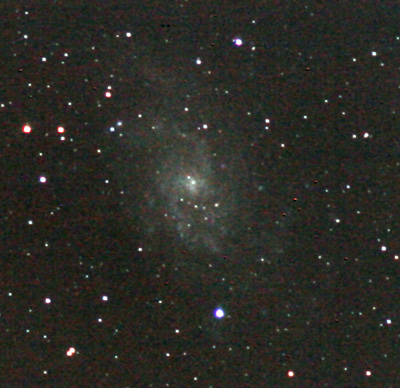
|
|
Here is the galaxy M33 as photographed from my back yard under rather mediocre
conditions.
This picture wasn't taken through a telescope - it was taken through a Nikon 300-mm f/4
telephoto lens attached to a Canon Digital Rebel body, with a didymium filter to
cut the skyglow from Athens' streetlights.
This is a stack of three 3-minute exposures, with a dark frame subtracted,
processed with Photoshop.
More about the techniques
here.
This time, however, I had an interesting addition to the gadgetry:
DSLR Focus, a software
package that allowed me to control the camera from my laptop and (as befits its name)
download test images immediately to check focus.
It even counted down the exposure time aloud.
"Ten, nine, eight..."
|
I'm ending the year early with this notebook entry.
If anything else happens, you'll hear about it in 2005!

|
 |
2004
December
29
|
Tsunami
The death toll from the Indian Ocean tsunami is more than ten times the original
estimates, and the shift in the position of parts of the earth's surface is reportedly
big enough to be measured with a GPS receiver.
 If you don't already have connections with a charity that is assisting the victims,
I suggest the Red Cross, to which you can make a donation
easily through Amazon's opening page,
or the (Baptist) International Mission Board
(also accepting donations on line).
The latter has a reputation as one of the most efficient charities in the world.
If you don't already have connections with a charity that is assisting the victims,
I suggest the Red Cross, to which you can make a donation
easily through Amazon's opening page,
or the (Baptist) International Mission Board
(also accepting donations on line).
The latter has a reputation as one of the most efficient charities in the world.
The biggest need will come a week to a month after the disaster, when the survivors
have been without food and sanitation for a long time, and when relief agencies
have used up their initial cash reserve.
The task is daunting, but the cost-effectiveness of any single donation is remarkable;
the money that feeds one person back home will feed twenty in the Third World.
Always deal with established charities that have low operating costs;
many of them are able to use your entire donation for disaster relief
rather than advertising or overhead.

|
 |
2004
December
28
|
More PIC history
Updated August 4, 2006.
The PIC1650 Programmable Intelligent Computer of 1977 may not have been the
beginning
of the PIC lineage.
It was certainly preceded by the same company's
CP1600 16-bit CPU.
Both of these were made by General Instrument Corporation, which also made amusing
chips such as the AY3 and AY5 families (which played music,
played Pong,
and so forth) and the
SP0256A speech synthesizer.
According to the
PIC FAQ,
the PIC architecture itself began with a Peripheral Interface Controller (circa 1975), which was an
I/O device for the CP1600 16-bit CPU.
However, I have not been able to confirm this by looking at old
General Instrument catalogues.
If the Peripheral Interface Controller was actually marketed, it is not in the 1977 catalogue.
The PIC1650 is the first PIC on which I can find any data.
Even if it began life as an I/O device, the PIC is certainly a real computer today.
Besides Microchip's excellent
assembler and debugger,
there are free compilers for
C,
BASIC,
and
Pascal
(all of them cut-down versions of commercial products),
as well as a tremendous number of other commercial compilers,
even though these programming languages started out on machines as different
from the PIC as an elephant differs from a swordfish.
Contrast that with the Atmel AVR architecture,
which was specifically designed to be programmed in C,
or the Intel 8051 and 8052 (now available from multiple vendors),
which have a strong family resemblance to the classic 8080 and 8086
and is good at running
something very similar to QuickBasic.
So was the PIC1650 the first microcontroller?
Apparently so.
I haven't been able to find anything earlier that combined CPU, memory, and I/O on a single chip.

|
 |
2004
December
27
|
Diamonds are forever, but quartz isn't
It's vacation week...so, assiduously avoiding my real job,
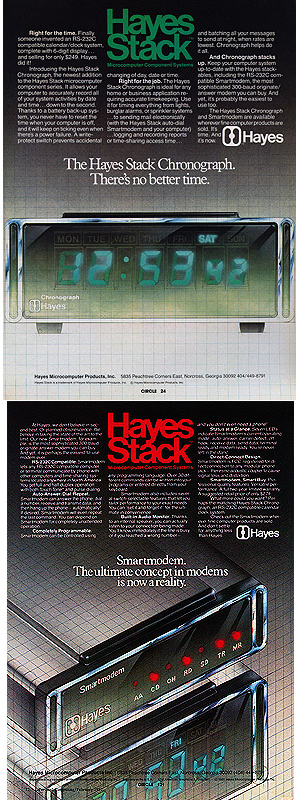 I spent part of this afternoon repairing an ancient but distinguished-looking
Hayes Chronograph
which we are now using as a clock in Melody's office area.
I spent part of this afternoon repairing an ancient but distinguished-looking
Hayes Chronograph
which we are now using as a clock in Melody's office area.
This is a high-precision timekeeping device that connects to the serial port of a computer.
Back in 1982, most computers didn't have internal clocks with battery backup.
The idea was that the computer would read the time from the Hayes Chronograph every time it booted up.
Well... This Hayes Chronograph had worked the last time I tried it (ten years ago), but today, its bright blue
display didn't light up.
A quick check showed that the power supplies were all OK (including 30-odd volts for the fluorescent display)
and the high-precision 32,768-Hz oscillator was running,
but there wasn't much action around the CPU, which was a PIC1650A.
In particular, there was no signal at its 4-MHz crystal.
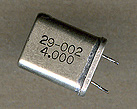 On a hunch, I tack-soldered a 5-MHz crystal across the existing 4-MHz one, and the unit came
to life. I then replaced the old crystal (shown here) with an exact replacement, and all was well.
On a hunch, I tack-soldered a 5-MHz crystal across the existing 4-MHz one, and the unit came
to life. I then replaced the old crystal (shown here) with an exact replacement, and all was well.
I then connected it to my serial port, launched Hyperterm at 300 baud, and set the time and date.
To my delight there was no Y2K problem with this device; it had no problem with the 21st century.
The lesson? As digital repair technicians know, but I was insufficiently aware,
quartz crystals are failure-prone.
Why shouldn't they be?
When controlling an oscillator, the crystal actually vibrates (in this case) 4 million times a second.
Mechanical impact or an electrical overload can destroy it.
Memorandum: When fixing old digital equipment that has been knocked around, consider the crystal.
The Hayes Chronograph was part of the short-lived "Hayes Stack" idea, which was that along with the
Hayes Smartmodem,
you'd get other computer peripherals in similar-looking extruded cabinets which
would stack neatly.
As far as I know, the Chronograph and the modems are the only products in the series that were
actually made.
(But a multi-user UNIX server might have a stack of modems.)
I have a collection of Hayes Smartmodems, not all of them working, in all the baud rates
from 300 to 14,400.
I should set them all up; their red LEDs would help light up the room.
All of these gadgets were invented by Dennis Hayes right here in Georgia.
He was one of the first people - perhaps the first - to have the idea of putting a
microcontroller inside a modem, so that the modem could (among other things) dial telephone
numbers under computer control.
Until then, you called up a distant computer by dialing the number yourself, listening for
the tone, and pressing a button or even (in really ancient times) placing the telephone
handset into a James Bond-like gadget with cups for the earphone and microphone.
Incidentally, that PIC1650A is only the second type of
PIC microcontroller
ever made.
The very first was the PIC1650, vintage 1977, whose manual has been
digitized by
Richard Ottosen.
From it we learn that PIC originally stood for Programmable Intelligent Computer
and that the instruction set hasn't changed much, although the pinout has.
Remember that microprocessors were invented in 1971; the PIC1650 must have been one
of the first microcontrollers, with CPU, RAM, and I/O devices all on one chip.

|
 |
2004
December
26
|
Curve shape and other matters
[Updated Dec. 26, 9:45 a.m.]
If the graph below intrigues you, click on it.
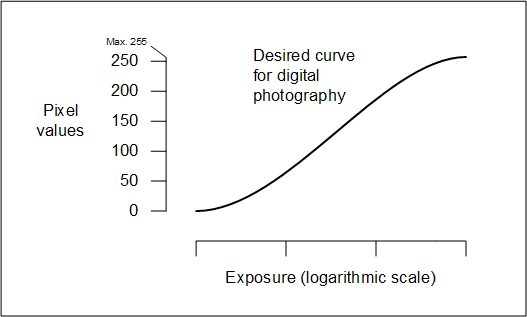
The sculptures in yesterday's picture are the nativity set that we normally display in the
living room at Christmas.
This year Cathy placed them on a light fixture that is on top of a bookcase, aimed upward to bounce
off the ceiling, like a light box.
My popular
tutorial on PIC assembly language for beginners, published in 1999,
is now
on line.
Enjoy!
As will be obvious, I spent much of my holiday writing prolifically
(even writing the Dec. 26 entry on the 25th and uploading it early).
But I don't want to give the impression that the Covingtons didn't celebrate Christmas.
On the contrary, with 16- and 19-year-old daughters helping, everything came off very
smoothly.
Cathy set up the Christmas tree, and it's one of the most beautiful ever.
As we traditionally do, we went to Vespers on Christmas Eve night, came home,
feasted on lasagna, and opened presents.
Then we spent Christmas Day resting and playing with our new toys, which in
Melody's case include a 20 GB pocket MP3 player.
Mine were a little more prosaic - an electric shaver, a new wallet, a
print viewing lamp for my desk, and best of all, a bit of free time.
Of course, Melody's and my big Christmas present was the Canon Digital Rebel that
arrived back in November, and with which we have now taken over 600 pictures.
How long did it take me to take 600 pictures with my first film SLR? A year or two?
Our prayers are with the people
of Sri Lanka and southern India, which have been hit by tidal waves from a terrible
earthquake. I have not yet heard from anyone specifically, but
over the years, many of my graduate students have been from Madras, the Indian
city that was hit hardest.

|
 |
2004
December
25
|
Astronomy and the Star of Bethlehem
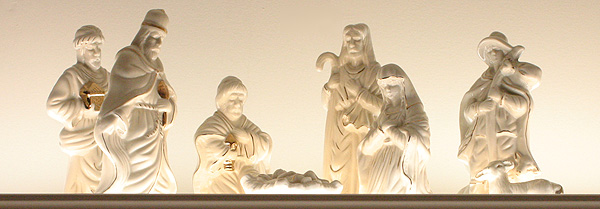
[Minor revisions Dec. 26, 2004, and Dec. 22, 2013. Some links may be obsolete.]
People often ask me what light modern astronomy can shed on the Biblical account
of the Star of Bethlehem. The bottom line is that
there is no simple, obvious astronomical explanation.
That doesn't mean it didn't happen - only that it cannot necessarily be
reconstructed today. Read on for the details.
First, note that the biblical account is extremely short and nontechnical.
Here it is, in its entirety:
Matthew 2:1-15 (ESV):
Now after Jesus was born in Bethlehem of Judea in the days of Herod the king,
behold, wise men [magoi] from the east came to Jerusalem,
saying, "Where is he who has been born king of the Jews? For we saw his star when it rose
[en tê anatolê]
and have come to worship him."
When Herod the king heard this, he was troubled, and all Jerusalem with him;
and assembling all the chief priests and scribes of the people,
he inquired of them where the Christ was to be born.
They told him, "In Bethlehem of Judea, for so it is written by the prophet..."
Then Herod summoned the wise men secretly and ascertained from them what time the star had appeared.
And he sent them to Bethlehem, saying, "Go and search diligently for the child,
and when you have found him, bring me word, that I too may come and worship him."
After listening to the king, they went on their way.
And behold, the star that they had seen when it rose [en tê anatolê]
went before them until it came to rest over the place where the child was.
When they saw the star, they rejoiced exceedingly with great joy.
And going into the house they saw the child with Mary his mother, and they fell down and worshiped him.
Then, opening their treasures, they offered him gifts, gold and frankincense and myrrh.
And being warned in a dream not to return to Herod, they departed to their own country by another way.
From The Holy Bible, English Standard Version, copyright 2001
by Crossway Bibles, a division of Good News Publishers. Used by permission. All rights reserved.
That's all. Children's Christmas pageants can stretch this out to last an hour, but we
actually have less than a dozen sentences, all of them nontechnical. Notice that the wise men
(Greek Magoi, Latin Magi) weren't "kings"
and there weren't necessarily three of them. Some further information about them,
not astronomical and of uncertain reliability, is passed down to us by
tradition.
Reportedly, 300 years later, St. Helena found their graves in Iran (Persia) and moved
their bodies to Constantinople.
But none of this sheds any light on the astronomical question.
So what did the Magi see?
A "star" could have been anything above the level of the clouds; the term did not
distinguish stars, planets, and comets.
Apparently, it didn't catch Herod's untrained eye; he had to ask
"what time the star appeared."
Where did they see it?
The phrase en tê anatolê is very ambiguous.
It may mean:
- "in the east," i.e., in the eastern sky;
- "in the east," i.e., they saw it when they were in Persia (?) before coming to Palestine;
- "in the rising," i.e., they observed its rising (thus the ESV translators);
- "in the rising," i.e., they observed its heliacal rising (the date of its first visibility before sunrise,
a standard way of calibrating the calendar against the stars), or possibly its acronychal rising, in the
evening at sunset (another way of calibrating positions).
We can't tell. St. Matthew was not an astronomer, and there is a strong tradition that says
that Matthew's Gospel (in Greek) was based on an earlier Hebrew or Aramaic version, which is all the
more reason not to expect it to use Classical Greek astronomical terms precisely.
We don't even know the year in which the star was seen.
In the Middle Ages, when Dionysius Exiguus replaced the old Roman calendar with the
"B.C.-A.D." calendar that we use today, he knew he couldn't reconstruct the exact date
of Christ's birth, so he made an arbitrary choice that may be as much as four years off,
or slightly more. Anything from about 6 B.C to 1 A.D. is reasonably likely.
And there's little reason to think Jesus was born on December 25.
The Bible doesn't give that date; it says shepherds were watching their flocks,
presumably waiting for pregnant ewes to give birth, which happens in the spring.
(Sheep are very inept mothers and need a lot of help on the spot.)
In the ancient world, the dates chosen to commemorate events were
not necessarily the anniversaries.
Many historians think that late December was chosen by the early Christians in order to wipe out some
pagan festivals that were previously held at that time.
Others point out that there was a widespread early belief that Jesus was conceived an integral number
of years before He died (or at least that's when his conception should be celebrated), and
His birth would therefore be assumed to be nine months after Easter.
So what was the Star of Bethlehem? There are several possibilities:
- It may have been a miracle, a non-physical event or a divinely caused deviation from
the laws of physics, in which case science cannot tell us anything about it.
- It may have been a natural event that can no longer be reconstructed, such as a
nova (temporarily bright star) or comet (making one trip to our part of the solar
system from far away, then receding far into space).
- It may have been a natural event that we can reconstruct, in which case it was
an alignment of planets that would be noticed by Persian stargazers but not terribly
conspicuous to non-experts, or else, possibly, a comet that can be identified with one
that has visited us again.
It is not at all clear what is meant by saying "the star went before them" (as they made the 6-mile
trip south from Jerusalem to Bethlehem) "until it came to rest over the place where the child lay."
How do you tell which building, in a small town, is directly under a star?
This argues for a miracle or an atmospheric phenomenon.
(See however my 2007 notes
for another possibility.)
Or it may just be an imprecise description.
The Gospel of Matthew can be divinely inspired without being scientifically detailed.
Quite likely, Matthew heard something more exact but didn't understand or reproduce it.
Among astronomers, the most popular theory about the Star of Bethlehem is that it was some type
of alignment of planets.
Frederick Larson pursues one version of this in great detail at
www.bethlehemstar.net - that it was an alignment
of Jupiter (the king of the planets) with the star Regulus (which symbolizes kings).
He tells his story in cliffhanger format, making it hard to skim.
In a couple of places he fumbles: he seems to be under the impression that
lunar and solar eclipses can occur on the same day, and his picture of a nova
is actually the Crab Nebula.
But he suggests, insightfully, that the way the star "came to rest over the place where the child lay"
is that it was a planet whose retrograde motion ceased just as the Magi reached Bethlehem.
Note that the Bible never asserts that the star led them there, only that it was
in front of them during their southward journey.
Michael Molnar pursues another in his
book,
The Star of Bethlehem: The Legacy of the Magi, which has gotten
good reviews from astronomers.
In his view, it was a passage of Jupiter (the king planet) across the constellation Aries
(which was thought to symbolize Judaea).
On shakier ground is an article by R. M. Jenkins in the latest issue of the
Journal of the British Astronomical Association
[full text link updated 2018] which
describes the Star of Bethlehem story
as "fictional" and based on Matthew's experience viewing Halley's Comet in 66 A.D.
It's possible that Matthew, a non-astronomer, was influenced by the comet, which he had seen,
when he tried to describe a phenomenon that he hadn't seen.
But "fictional"? The Gospels aren't fiction.
Whehter or not you agree with what they say, they are frank accounts of what people thought
had actually happened.
As C. S. Lewis astutely pointed out, they contain lots of detail that would not have appeared in any
kind of fiction that was known in ancient times. Thomas Hardy and Jane Austen, with their modern realistic
writing styles, hadn't come along yet.
So we must dismiss Halley's Comet as having been 70 years too late.
[Note added 2018:] One point that some Star of Bethlehem investigators seem to miss is that,
whether or not you believe its claims, Christianity started out as a community.
Do not imagine a few people writing the Gospels and other people later deciding to believe them.
No; the Gospels are a record of the information the community was already passing along.
Many members of the community must have known the local history (governors, censuses, etc.) better
than modern archeologists do, and if the Gospels had contained obvious errors about such things, they would have
been corrected at the time. This is so even if you think the religious claims are fictional.
In all of this, we are like the drunkard who looks for his keys under the lamppost - even
though that's not where he lost them - because "the light is better."
Most of the possibilities for the Star of Bethlehem - even fairly common phenomena such as novae - just
aren't reconstructible.
Further web references are provided by the
Griffith Observatory.
For more about the Star of Bethlehem, see my follow-up entry posted on
Christmas 2007.
Merry Christmas!

|
 |
2004
December
24
|
Merry Christmas Eve!
Today is the last shopping day, and around Athens, shopping-center parking is becoming
a contact sport played with SUVs and cellphones.
Not for me. I'm going to do some shopping on December 28th!
A few more notes about microcontrollers:
I'm actually not very fond of the quirky PIC architecture, and after using up my present stock of
chips (which may take a while), I'm planning to switch to the
Atmel AVR architecture, for which you can get,
among other things, a pretty good
free BASIC compiler
(BASCOM demo, which is code-size limited)
as well as Atmel's free assembly-language development system.
As best I understand it, all the AVR chips have the same architecture
(thus no differences in programming - just things left out from the smaller chips),
and even in assembly language, they're easier to work with than PICs.
 Why not call it Christmas?
Jeff Duntemann has voiced a pointed
critique
(to be archived
here)
of the current fad for
not calling Christmas by its proper name.
Have you notice that it's not Christmas any more; it's "the holidays," and people
have "holiday trees" and send "holiday cards"?
Why not call it Christmas?
Jeff Duntemann has voiced a pointed
critique
(to be archived
here)
of the current fad for
not calling Christmas by its proper name.
Have you notice that it's not Christmas any more; it's "the holidays," and people
have "holiday trees" and send "holiday cards"?
Or even "Holiday." According to this package, Santa Claus comes on "Holiday 2004."
What next, "I'm Dreaming of a White Holiday"?
I have long said "happy holidays" to non-Christian friends who were celebrating Hanukkah or
something else around the same time.
But December 25 is Christmas and nothing else.
Hanukkah was some days ago, and even the winter solstice is past.
More to the point,
it looks silly to say "the holidays" while referring to what is obviously just one
holiday.
I suppose some people feel they are avoiding sacrilege by removing Christ's name from a
very secularized festival.
But many of us are beginning to feel that the overall effect is suppression, not respect.
There is nothing offensive about calling a religious holiday by its own name,
even if you celebrate it in attenuated form or not at all,
and especially if you call all the other religious holidays
by their right names.
Tomorrow's topic: astronomy and the Star of Bethlehem.
Merry Christmas!

|
 |
2004
December
22-23
|
Miscellany
Aladdin's Cave is now empty.
The huge donation of electronic parts (about 40,000 components, all in reusable cabinets)
has been moved to the electronics lab in our
Driftmier Engineering Center
and I have my office back.
I've been playing around a bit with
PIC microcontrollers
(see also
here
and
here)
to make some timing gadgets for astrophotography.
A microcontroller is a complete computer (CPU, memory, and I/O) on a single chip,
typically costing about $1, and capable of running simple assembly-language programs.
They're found in such things as digital clocks,
watches, thermostats, toasters...
PIC is one particular brand of them, with a particularly simple instruction set
and low price.
Now that microcontrollers are so cheap, my question is this:
Why hasn't multiple-CPU design caught on?
It's much easier to make two computers do two things
than to make one computer do two things.
If I were building a timer, I'd have one CPU provide a precision 0.01-second
time base - and nothing else - while the other CPU counted the pulses and
acted upon them.
No interrupts, no multitasking. Just two CPUs, only one needing a precisely
controlled clock speed. Why not?
As soon as we get some clear weather, please
go look at
Comet Machholz.
Several days ago, it was already visible to the unaided (but trained) eye
from my home.
It should be an easy naked-eye sight from the country.

|
 |
2004
December
20-21
|
Short notes
Today I've been catching up on linguistics.
Another incisive critique of Chomsky's minimalism, from
a completely different angle than
Seuren's,
is the one by
Pinker and Jackendoff.
Look at page 19 of it.
For the astrophotography crowd, yesterday I wrote
this note
about the Canon Angle Finder, an SLR viewfinder attachment that gives 2.5x magnification
(on top of what you already have, i.e., about 12x net).
It fits a wide variety of SLRs, not just Canons.
And my office has turned into an electronic Aladdin's Cave.
Someone has donated about 20,000 electronic components to the University,
comprising resistors, capacitors, diodes, transistors...
and at the moment they're all in my office waiting to be identified.
Fortunately they are all in anti-static cabinets comprising hundreds of little drawers!

|
 |
2004
December
19
|
Fourth Sunday in Advent
I want to thank the late
Charles M. Schulz, cartoonist,
creator of
Peanuts (Charlie Brown and gang),
for doing an important thing to keep Christ in Christmas.
Thanks to Mr. Schulz's insistence,
the Peanuts TV special, "A Charlie Brown Christmas,"
contains part of the Christmas narrative from the Gospel of Luke.
Here it is:
And there were in the same country
shepherds abiding in the field,
keeping watch over their flock by night.
And, lo, the angel of the Lord came upon them,
and the glory of the Lord shone round about them:
and they were sore afraid.
And the angel said unto them,
Fear not: for, behold, I bring you good tidings
of great joy, which shall be to all people.
For unto you is born this day
in the city of David a Saviour,
which is Christ the Lord.
And this shall be a sign unto you;
Ye shall find the babe wrapped in swaddling clothes,
lying in a manger.
And suddenly there was with the angel
a multitude of the heavenly host
praising God, and saying:
Glory to God in the highest,
and on earth peace,
good will toward men.
This is the only thing many American children ever hear
about the real significance of Christmas.
Thank you, Mr. Schulz.
Happy Fourth Sunday in Advent!

|
 |
2004
December
18
|
Miscellany / Demise of Kodachrome?
Silliest computer accessory of the year: Click
here.
This thing actually mounts in a 5 1/4-inch drive bay.
Meanwhile, the tiny kingdom of Bhutan has become the
first nation to ban tobacco.
How many more will there be in my lifetime?
Remember that during the first 200 years of its popularity
in Europe, tobacco was considered
very dangerous.
[Link corrected Dec. 22.]
Its relatively brief heyday spanned about 1850-2000.
Now, good riddance!
 Here is an
interesting discussion of the (rumored) imminent demise of Kodachrome film
with information from a Kodak insider.
Kodachrome 25 has been discontinued; Kodachrome 64 and 200 are apparently doomed,
because Kodachrome processing is now done at only two or three labs worldwide.
Here is an
interesting discussion of the (rumored) imminent demise of Kodachrome film
with information from a Kodak insider.
Kodachrome 25 has been discontinued; Kodachrome 64 and 200 are apparently doomed,
because Kodachrome processing is now done at only two or three labs worldwide.
In fact, a few years ago, Kodak was all set to re-engineer Kodachrome and introduce a 400-speed version,
but the professional photographers who received samples under nondisclosure didn't like them.
What's killing Kodachrome is really the expense of processing it.
Only a few labs can afford to do it at all, but the public expects it to be as cheap
as processing Ektachrome.
There is also the widely held belief that Kodachrome "gives the best color."
Does it?
In 1965 it did; Ektachrome was rather primitive back then, and the slides tended to fade.
Those problems have been overcome.
The last time I used any Kodachrome, I was struck by the high contrast, poor color gamut,
and grain. Ektachrome-type films such as Kodak E200 are better, especially now that manufacturers
have figured out that not everyone wants super-saturated colors.
What's interesting is that the patents on Kodachrome expired long ago, and if anybody else wanted
to make a Kodachrome-type film, they could.
It's been tried twice.
Sakura slide film, in Japan about 40 years ago, was a Kodachrome clone, and so was Dynachrome,
an American product of the same vintage.
The Sakura film was reportedly quite good, but everybody soon switched to Fujichrome (an Ektachrome clone).
Dynachrome was never impressive, and the company lost money.
Yet a lot of photographers say that only Kodachrome 25 looks right.
So I ask: Does Kodachrome have the most accurate colors, or merely
the ones the photographers have learned to previsualize?
I recently took the last rolls of Kodachrome out of my freezer and
sold
them to a
photographer who is going to do something historic with them, but I'm sworn to secrecy
until the time comes.

|
 |
2004
December
16-17
|
Gradients, griefers, grouches, and good humor
My main accomplishment on the Web lately has been
this
disquisition on how to compensate for vignetting using Photoshop's gradient tool.
I may not have gotten it exactly right.
Photoshop wizards, please correct me.
No sooner did I write about griefers than one of them attacked me
(and many other people) in several newsgroups.
Fortunately, in a discussion forum, unlike a game, it's not possible for a griefer to
actually block other people's activities.
All he can do is convince us he's an idiot.
Meanwhile, in one of the large organizations that I work with,
I've noticed another sign of bad management:
When people start saying, "It's easier to get forgiveness than permission"
- that is, when people are penalized for asking permission to do things -
you've found a problem.
To those involved in one instance of this recently, I've had to say:
Why not just do the job right in the first place?
Why not make policies that actually say how things are supposed to work,
and then follow them?
But there's plenty of good humor in the world.
Let me recommend for instance
this classical music video,
one of the funniest things I've seen lately.
Never mind that it's narrated in French and captioned in Icelandic.
Just enjoy it!

|
 |
2004
December
15
|
Astrophotography can be this easy
Here is a sample of just how easy digital astrophotography can be.
Take your Digital Rebel outdoors, put it on a tripod, activate the self-timer
(delayed shutter release), set the mode to Manual, shutter to 8 seconds, and
lens wide open. Manually focus very carefully on the brightest star you can find.
Take the picture. Here's what you can get.
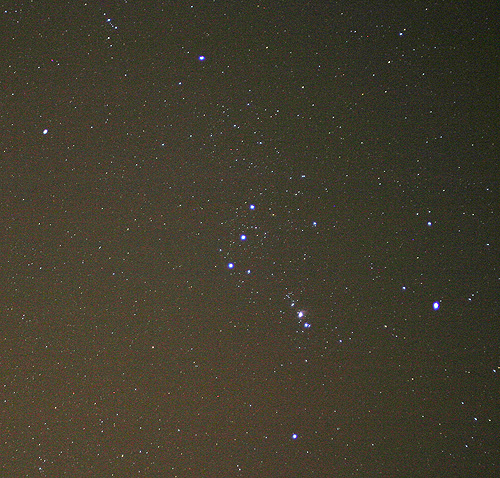
The picture was adjusted with Photoshop, of course: I set the levels to bring out a lot
of stars, resampled it down to the size you see here, and used "Sharpen" to intensify
the stars that almost got lost in the resampling process.
The lens I happened to be using was an East German Zeiss Flektogon, 35-mm f/2.5, but any
newer lens with similar parameters (e.g., 35/2.8) will do fine.
This old screw-mount lens was attached to the Digital Rebel with an adapter
I bought on eBay. (Search for "M42 EOS adapter.") I am glad to report that this
adapter is more mechanically sturdy than the common Nikon-to-EOS adapter.
Also, good screw-mount (M42, Pentax-Praktica)
lenses are cheap, because Pentax started making
very good ones just before they discontinued the screw mount altogether,
and East German Zeiss kept making them into the 1980s.
There are some awful M42 screw-mount lenses, too.
Avoid the Meyer Primoplan unless you like unusual optical effects.
"Griefers"
[Minor revision Dec. 26.]
CNET has an interesting news story
about
"griefers,"
people who join online games not to play and win, but simply in order to give grief to other players
through sabotage and dirty tricks.
As online simulation games become more like real life,
they become better at bringing out the worst in some people.
Although the name "griefer" is new, we've had griefers in Usenet newsgroups for years.
Just yesterday I dealt with someone who was posting anonymous obscene messages, forged messages
under other people's names, and messages that were meant to harass.
He thought he was perfectly anonymous.
Of course, all of his messages, under many names,
were traced back to the same computer.
Part of the cure is simply to hold people accountable.
Why should the Internet - or the telephone - give people a perfect place to hide?
Back when Caller ID came in, many years ago, there were bitter protests about how it would
deprive people of their "privacy."
But when you're bothering me you don't have a right to "privacy."
Privacy is what you have when you're by yourself.
I think that by now, everyone understands this, and nobody would want Caller ID to go away.
The same goes for greater accountability on the Internet, if we can get it.
What's so great about letting people join communities without revealing to anyone at all
who they really are?

|
 |
2004
December
14
|
Miscellany
Yet another reason why
working for an idiot
is bad for you:
it causes
heart attacks.
You have been warned!
Congratulations to graduate student Cati Brown, a member of my research group, who has
had an article accepted by the prestigious
Journal of Pragmatics.
(It's not mentioned on their web site yet, but it soon will be.)
Pragmatics is the study of language in context.
Cati's article is a study of tobacco industry documents, showing (roughly)
how people talk when they're lowering their ethical standards.
(For example, they shy away from the word because because it implies too much responsibility.)
Details about the research project are
here.
This is a research project I'm not personally involved in, but I wish it well.
And I suspect Cati's dissertation will become a bestselling book!

|
 |
2004
December
13
|
Miscellany
There should be a fine meteor shower tonight, the Geminids.
This shower is noted for slow, bright meteors; you can expect to see one every two minutes or so.
Last night, from home, I saw perhaps a dozen meteors in 45 minutes of skygazing, and two thirds
of them were first magnitude or brighter.
The maximum is tonight around midnight.
More information here
and here.
Sky and Telescope reports that this shower is growing in intensity from year to year.
What we're dealing with is a swarm of rocks that orbit the Sun. Every year, in our own orbit,
we meet it. Apparently, our orbit is currently bringing us into a thicker part of it than it used to.
Spelling error of the day: It's not Adeste fidelis, it's Adeste fideles (plural).
(If you're a Marine, Semper fidelis. If you're a platoon of Marines, Semper fideles...)
A nice animation of Comet Machholz has been
published by Steve Smith.
It shows the comet moving relative to the stars for about an hour.
Digital cameras seem to have given rise to a new superstition, "orbs."
It is well known that the camera flash can illuminate dust particles in the air just in front of the
lens. (Digital cameras have the flash very close to the lens, which is also why "red-eye" is
such a problem.)
Well...
Some people
claim "orbs" are, in some cases, the spirits of the departed (or something).
Then there are "rods," apparently
elongated images of flying insects - unless of course you're a UFO believer, in which case
they're...who knows what?

|
 |
2004
December
12
|
Third Sunday in Advent
The best-known Latin Christmas hymn, Adeste Fideles
("O Come All Ye Faithful"), is also the
least ancient.
Not a product of the medieval Church, Adeste Fideles
was reportedly written around 1743 by a Latin scholar in England,
John Francis Wade,
though he may have gotten it from an earlier source.
Adeste fideles looks like the work of a scholar because it begins with a very rare verb form
(the imperative of adesse 'be present').
A native or near-native speaker of Latin would have said venite.
While looking around on the Web, I found 2 versions of a line in the second verse:
Deum de Deo, lumen de lumine,
Gestant puellae viscera,
[Parturit virgo mater,]
Deum verum, genitum non factum.
Venite, adoremus,
Venite, adoremus,
Venite, adoremus, dominum!
Translating literally:
God from God, light from light,
The young girl's womb carries
[The virgin mother gives birth to]
True God, begotten not created,
Come, let us adore,
Come, let us adore,
Come, let us adore the Lord.
I don't know which is original.
Gestant puellae viscera is what I've always heard; it is clumsily worded
but fits the meter. (I've translated it sympathetically; viscera means "innards.")
Parturit virgo mater makes a lot more sense but doesn't fit the meter.
Anyhow, what I particularly like about this verse is that it paraphrases part of the
Nicene Creed,
making a subtle point about the relation of God the Son to the Father and the Holy Spirit.
The Son is "God from God, light from light, true God from true God,
begotten, not created," which means that the Son is in
some sense dependent on, but not historically created by, the Father.
I like hymns that are strong on theology.
I suppose this marks me as a churchgoing nerd;
but I think the accumulated wisdom of the Church is valuable.
Catholics will note that John Francis Wade also gave us one of the most popular
musical settings
of St. Thomas Aquinas' Tantum ergo sacramentum
("Humbly let us voice our homage / For so great a sacrament") - another hymn
for theological nerds.
Protestants have set a number of other good hymns to the same tune,
slightly altering it here or there,
such as
this
and
this.
Happy Third Sunday in Advent!

|
 |
2004
December
11
|
Digital Rebel astrophotography
My main literary output today, so to speak, was
this
rather detailed guide to how to use a Digital Rebel as an astrocamera.
Chomsky exploded?
[Unlike my usual practice here, in what follows I'm actually going to talk
about what I do in my day job. By training I am a theoretical linguist.]
I'm reading
Chomsky's Minimalism, by
Pieter A. M. Seuren,
which attempts to blast to shreds most of the linguistic theories
advanced by Noam Chomsky since about 1970.
It is all the more impressive if you've met Seuren (as I have) and realize that he is a very
mild-mannered person.
And let me say at the outset that I do not deny that Chomsky is a great linguist.
His Syntactic Structures (1957) was absolutely fundamental.
It unlocked the puzzle of how to describe the syntax of human languages.
But not everything subsequent has been as good.
Seuren's main bones to pick with Chomsky are the same as my own, namely:
- Chomsky insists on describing grammar as a process that cannot possibly be real.
We don't talk by first deciding to create a sentence, and only later finding out how to pronounce it
and what it means.
(Well, at least most of us don't.)
So why insist on describing grammar as a process arranged that way?
Seuren wants to push toward a process that computes pronunciation from meaning.
I'd rather say (agreeing with Chomsky in one of his moods) that grammar is a set of structural constraints,
not a mental process; the constraints describe what the mental process produces, but not how it produces it.
It can be legitimate to describe a complicated relation by giving a procedure to generate it.
(Imagine describing a geometrical shape by giving people step-by-step instructions to draw it.)
But after 47 years, we ought to be able to step back and look at things another way.
- The empirical content of Chomskyan linguistics has been declining since the 1970s.
That is, Chomskyans no longer produce insightful descriptions of languages.
The latest version of Chomskyanism is notable for its ability and determination to
sweep counterevidence under the rug.
It floats high in the air, unconnected to the empirical ground.
When a Chomskyan manages to be a good all-around linguist (as Andrew Carnie, Ian Roberts,
and Andrew Radford have done), it's by not clinging to Chomskyanism itself.
Those three linguists have impressed me with their actual success in describing how
human languages work.
And it's no coincidence that all three of them have written textbooks.
When you write a textbook, you have to grapple with data; you can't just wave your hands.
The best thing about Chomsky's GB theory, in the 1980s, is that it gave us names for
grammatical relations and phenomena (Complement, Adjunct, Specifier, Case).
All that has been swept away in the latest theory, which is called Minimalism,
and we're not sure what we're left with.
- Chomsky's exposition is obscure and contradictory.
Really, if you want people to read books, you have to write more systematically
than Chomsky does!
It's not surprising that three linguists can read the same book and come away
with three completely different theories.
- Sociologically, Chomskyanism is as much an ideological movement as a set of scientific proposals.
Chomskyanism seems to be dominated by an "in-group" in a way that the leading theories in semantics,
psycholinguistics, and other areas are not.
Seuren wants to rehabilitate Generative Semantics, a theoretical movement of the late 1960s
that viewed grammar as a set of recipes for converting meanings into pronunciations (or the
inverse). It would indeed be interesting to see what Generative Semantics could do with the
tools of modern semantics, unification-based grammar, theory of algorithms, and so forth.
But I think we need not go that far.
I think grammar is distinct from psycholinguistics;
you can study what the brain does without studying how it does it.
Just don't present the grammar as if it were a mechanism.

|
 |
2004
December
9-10
|
Comet Machholz and Anthony Flew
We live in remarkable times.
There's a fifth-magnitude comet in the evening sky,
and Anthony Flew has become a theist.
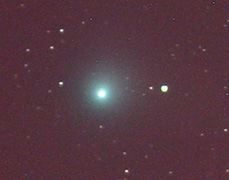 Let me deal with the first of those first.
Comet Machholz is going to be visible for several weeks as it works its way
northward through Eridanus to Taurus and on from there.
Details and maps here;
precise ephemeris for observers here.
Let me deal with the first of those first.
Comet Machholz is going to be visible for several weeks as it works its way
northward through Eridanus to Taurus and on from there.
Details and maps here;
precise ephemeris for observers here.
We're viewing this comet head-on.
Its tail points away from us because it is farther from the sun that we are.
The tail of a comet, you'll recall, consists of gas driven off by the heat and photons
of the sun; it always points away from the sun regardless of which way the comet is moving.
Meanwhile, Anthony Flew, one of the most outspoken atheists of the 20th Century,
has announced that he has come to believe in some sort of God, although not a personal one.
This will leave some people in shock.
News story here;
detailed interview here.
What convinced Dr. Flew is evidence of intelligent design - evidence that the universe is not,
after all, a coincidence - and although he does not cite it, one of the best presentations
of that kind of evidence is Owen Gingerich's, here.
We may be reaching the end of 100 years of overconfidence in Darwinian evolution.
Darwin, after all, pointed out that his theory assumed you already had lifeforms
that were capable of reproduction and heredity.
Others somehow took "evolution" to be the sum total explanation of everything.
It isn't.

|
 |
2004
December
8
|
Hanukkah for Christians
 I want to wish everybody (not just my Jewish friends) a happy
Feast of the Dedication, or Hanukkah as it is called in Hebrew.
I want to wish everybody (not just my Jewish friends) a happy
Feast of the Dedication, or Hanukkah as it is called in Hebrew.
Hanukkah commemorates the rededication of the Temple in Jerusalem in 165 B.C. after
the Greeks had desecrated it during the Maccabean Revolt.
Details here.
It also commemorates a minor miracle in which the temple lamp ran for
eight days on one day's supply of oil.
What Christians don't realize is that Jesus was reportedly present at a Hanukkah celebration
(John 10:22)
and that was when he gave his "Good Shepherd" sermon.
(Click on that link; it's a very handy online Bible.)
Hanukkah has, of course, nothing at all to do with Christmas except that it falls at very
roughly the same time of year.
But it is something Christians can certainly celebrate - after all, that was our history too! -
and an inspiration to freedom-loving people anywhere.
Picture of a meteor impact?
Mystery picture:
Check out the picture
here
and the associated links.
It may show a meteor impact.
Or maybe it shows a light bulb exploding - except for the unexplained dark streak to the upper left.
Is there a way a CCD camera can produce a diagonal streak as an artifact from a
strongly overexposed spot?
My own theory is that it is a flash exposure of an insect near the camera,
which then, after the flash, flew in a straight line toward the upper left.
I've seen contrast-enhanced versions of the image in which the "explosion"
and "smoke cloud" look very like a fly.
The EXIF data on the file show that it was a 1/20 second exposure and that the
flash was fired. The flash probably comprised the first 1/1000 second or less,
after which the fly would simply leave a dark trail.
Experts seem to agree that a meteor would not have been flying fast, in a straight line,
that close to the time of impact.
The air would have slowed it down severely.
Miscellany
The DDoS attack against spammers
that I recently
mentioned
has been
called off
and (what's worse) a
counterfeit
version of it (a Trojan horse) has been circulated.
During its brief heyday, it apparently
took down 2 spam sites in China.
The oddest online zoo (of manipulated pictures) that I've ever
seen is here.
I liked the bulldog-ape best.
Leave it to the Russians!

|
 |
2004
December
7
|
"North American Nebula" or "North America Nebula"?
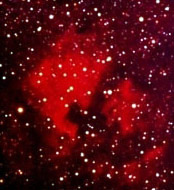 The nebula NGC 7000 looks remarkably like a map of North America - so much so
that once, when speaking to the British Astronomical Association in London,
I pointed to a spot on it and said, "I live here."
The nebula NGC 7000 looks remarkably like a map of North America - so much so
that once, when speaking to the British Astronomical Association in London,
I pointed to a spot on it and said, "I live here."
Some people call it the North America Nebula, a name which, to me, makes
perfect sense.
Others call it the North American Nebula, which looks wrong... after all,
we don't have an Andromedan Galaxy or an Orionian Nebula, and anyhow,
this one is like North America, not in or from it.
I'm a North American.
It isn't.
Mere pedantry, however, is not sufficient to establish its real name.
What should we be calling it?
Reference books are split.
Many say North America Nebula, but Robert Burnham's
magnificent and influential
Celestial Handbook
(Vol. 2) consistently calls it North American.
The nebula was first photographed by Max Wolf in 1890,
bringing out its North American shape for the first time.
(It looks more uneven when viewed with a telescope.)
You can see Wolf's photograph on line in the
Publikationen
des astrophysikalischen Observatoriums Königstuhl-Heidelberg
(Vol. 1, 1902, frontispiece).
Wolf named it Der America-Nebel (not Der amerikanische Nebel) -
"The America Nebula," not "The American Nebula."
The Germans today call it Der Nordamerika-Nebel.
Based on this, I think the mistake was Burnham's.
For all his achievements, Burnham was not the world's best
speller.
He misspells the name of the constellation Piscis Austrinus
throughout his handbook.
And I think he fumbled this one, too.

|
 |
2004
December
6
|
Saint Nicholas' Day
 Today is the anniversary of the death, in 343 A.D., of St. Nicholas,
Bishop of Myra in what is now Turkey.
Today is the anniversary of the death, in 343 A.D., of St. Nicholas,
Bishop of Myra in what is now Turkey.
Although his actual deeds are a bit hard to separate from stories that
became attached to him later, Bishop Nicholas had a reputation for
anonymously assisting poor children.
He is definitely a recorded part of church history: he attended the Council of Nicaea.
Today he has his own
web site,
which I thank for the clip-art image shown herewith.
In Dutch, Saint Nicholas is Sint Niklaas,
which New Yorkers, around 1800, turned into Santa Claus, the
completely fictitious character of children's stories,
and today the symbol of Christmas shopping.
Melody and I chose not to bring up our children to believe literally in Santa Claus.
We gave them Christmas presents and we told them the Santa Claus stories, but we never
led them to believe that Santa really exists.
The reason?
Partly that we didn't want to buy into the materialistic greed
that Santa now symbolizes,
and partly that we didn't want to have to disillusion them later.
We did not want to teach our children that happiness comes from
believing things that are not true,
and is doomed to end when you find out the truth.
Whenever you talk about an "old-fashioned Christmas," remember that
Christmas was a relatively minor holy day until the 1800s;
the Santa Claus story didn't take solid shape until
"'Twas the Night Before Christmas" came out in
1822,
and Santa wasn't a big part of American childhood
until about 1950.

|
 |
2004
December
5
|
Second Sunday in Advent
The Fourth Eclogue of Vergil (Virgil),
the same pagan Roman poet who wrote the Aeneid,
describes a boy whose birth will usher in a golden age
and change the world.
Written perhaps 30 years before the birth of Jesus,
it has sometimes been interpreted as a pagan prophecy of Christ.
In fact, the Fourth Eclogue is summarized
in the last verse of "It Came Upon a Midnight Clear":
For lo! the days are hastening on,
By prophet-bards foretold,
When, with the ever-circling years,
Shall come the Age of Gold;
When peace shall over all the earth
Its ancient splendors fling,
And all the world give back the song
Which now the angels sing.
The author of this familiar Christmas carol was a Unitarian who presumably
did not believe Jesus was God Incarnate (Unitarians don't).
Examined closely, his song communicates a heartwarming message of
hope - just like Vergil's - but no specifically Christian theology.
In any case, the Fourth Eclogue is beautiful poetry, and whether Vergil
knew it or not, it does paint a picture applicable to Jesus.
My favorite line is:
Incipe, parve puer, risu cognoscere matrem
'Begin, little boy, to recognize your mother with a smile.'
There was a time when God Incarnate did exactly that.
Happy Second Sunday in Advent!

|
 |
2004
December
4
|
What high-school football has done for astronomy
Today Melody and I went to Atlanta to talk with people from Nikon
(and, as it turned out, also Canon) about digital astrophotography.
We've crossed a big threshold just lately:
mass-market digital SLRs, though not perfect for astronomy,
are in many circumstances as good as film
if you stick to reasonably simple techniques.
 Astronomers owe a lot to high-school football.
Astronomers owe a lot to high-school football.
Specifically: High-school football is the reason good sports photography
goes on in every town every week.
And that is why Nikon and Canon can sell giant, high-quality,
fast telephoto lenses like the one in the picture
(Nikon 300/2.8).
And those are the best lenses for reasonably inexpensive deep-sky imaging.
So high-school football is subsidizing astronomy.
One of the high points of the day was shaking hands with
Jay Maisel,
one of the greatest living photographers
(see also here
and here).
It was only a momentary meeting -
no great artistic genius imparted to us - but afterward,
Melody,
who knows more about Mr. Maisel's work than I do, felt inspired to go outside and
photograph patterns of light and shadow in the courtyard, while I,
not knowing where she was, cut short a
conversation with a Nikonian in order to go and see if she had fallen ill.
I've found, on line, a set of
MTF curves for Nikon and Canon lenses.
Links here.

|
 |
2004
December
3
|
A rare beast
 Today, as far as I could make out,
there were only
2 rolls of Kodak color slide film for sale
in our town of 100,000.
I bought one of them.
Here it is.
Today, as far as I could make out,
there were only
2 rolls of Kodak color slide film for sale
in our town of 100,000.
I bought one of them.
Here it is.
(I've just thought of another camera store on the other side of town
that I didn't try. There may have been half a dozen rolls there, too.
Still, the stuff is scarce.)
I want to do film-versus-digital comparisons.
Obviously, one needs film to do this.
There is no longer any color slide film at Wal-Mart.
Color print film is still around, but only purists use slide film.
The purpose of slides is mainly to be reproduced in some other form,
and the people who take color pictures for publication have all gone digital.
At camera stores, there's a lot of Fuji color slide film and just a bit of Kodak.
That, in itself, is strange; I can remember when nearly all the film on sale in
this country was Kodak; you'd have an expanse of yellow boxes with a few red GAF ones
and maybe an orange Agfa box or two.
But in 1970, American photographers went to the Osaka world's fair and came
back with Fuji film.
That began the invasion of the green boxes.
I have nothing against Fuji except that their films aren't sensitive to the deep
red (656 nm) light of hydrogen nebulae.
Neither are digital SLRs, but they can be
modified to be.
Tomorrow Melody and I are off to the
Atlanta Photojournalism Seminar to meet
with experts from Nikon and talk about how to build a better digital SLR.
Maybe I'll have some influence on the Nikon D300 or whatever it ends up being called.
But getting back to film,
John Dorio
is taking fine pictures of galaxies on Kodak T-Max 400 film,
which has a subtle range of gray tones that Technical Pan couldn't match.
Mallas and Kreimer's Messier Album was photographed largely
with Tri-X Pan.
Maybe we've abandoned traditional black-and-white films too quickly.

|
 |
2004
December
1-2
|
DDoS against spammers?
I'm not quite sure whether this will pass legal and ethical scrutiny,
but I hope it does.
It certainly has the backing of a major Internet provider, Lycos.
The idea is to conduct a
DDos
attack against spammers.
DDoS stands for distributed denial of service.
It's what happens when a lot of computers gang up against their victim,
flooding it with data or requests for data.
Here's the idea.
Spammers always give you a web address to click on to buy their products.
But they expect almost everybody to ignore it.
They're counting on 99.999% of us to discard the spam or never receive it.
That's why they send a million messages to make a dozen sales.
Well...
What if they actually got a response to every message?
Their servers would be overrun with traffic, and 99.999% of it would be people
who aren't buying anything.
Further, what if the responses were made, not by a web browser, but by a special
program that runs only when your computer has spare time,
and won't display, or respond to, anything it gets?
That way your computer can't be sabotaged by malware on the web site.
That's Lycos's idea, so they've put this program into a screen saver.
Reportedly, it limits its activity so as not to actually flood channels
with data - just make spamming more expensive.
Anybody who sends out a million invitations had better be
prepared to get a million responses.
What I like about it is that the people who host spammers' web sites
will have to take action.
Right now, spammers set up their web sites on ISPs that have a reputation
for not listening to complaints.
Well...ignoring a complaint is one thing...ignoring a tremendous flood
of traffic is another.
If you host a spammer, he's going to take up 99% of your server capacity
if you let him.
But there's a possible serious flaw:
spammers could send out messages with innocent web addresses in them,
causing the innocent victims to be flooded.
(Just as they use innocent people's return addresses - including mine - already.)
I'm not sure how Lycos is going to handle that.
[Addendum: The answer is that this program does not react to your incoming e-mail.
Instead it works from a list of known spam sites maintained by Lycos.
I do wonder who is going to manage to sue them, and on what grounds.]
Another anti-spam tactic:
For the first time, the top of this page has live e-mail links which are
invisible to spam-bots (the programs that read web pages and collect addresses for
spamming).
It's done with JavaScript, thanks to
Will Fastie,
who got back in touch with me recently...
in the mid-1980s, he was editor of PC Tech Journal
and I was a contributing editor.
Never put your e-mail address on a web page as plain text.
If you do, spammers will "harvest it."
"Mailto" links are especially bad (unless obfuscated the way mine is).
A simple way to display your e-mail address
without giving it to spammers is to put it in a graphic.
That's what I did until today.

|
 |
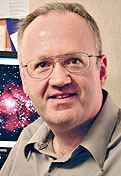

![]()



 On a hunch, I tack-soldered a 5-MHz crystal across the existing 4-MHz one, and the unit came
to life. I then replaced the old crystal (shown here) with an exact replacement, and all was well.
On a hunch, I tack-soldered a 5-MHz crystal across the existing 4-MHz one, and the unit came
to life. I then replaced the old crystal (shown here) with an exact replacement, and all was well.


 Why not call it Christmas?
Jeff Duntemann has voiced a pointed
Why not call it Christmas?
Jeff Duntemann has voiced a pointed


 Let me deal with the first of those first.
Comet Machholz is going to be visible for several weeks as it works its way
northward through Eridanus to Taurus and on from there.
Details and maps
Let me deal with the first of those first.
Comet Machholz is going to be visible for several weeks as it works its way
northward through Eridanus to Taurus and on from there.
Details and maps  I want to wish everybody (not just my Jewish friends) a happy
Feast of the Dedication, or Hanukkah as it is called in Hebrew.
I want to wish everybody (not just my Jewish friends) a happy
Feast of the Dedication, or Hanukkah as it is called in Hebrew.
 The nebula NGC 7000 looks remarkably like a map of North America - so much so
that once, when speaking to the British Astronomical Association in London,
I pointed to a spot on it and said, "I live here."
The nebula NGC 7000 looks remarkably like a map of North America - so much so
that once, when speaking to the British Astronomical Association in London,
I pointed to a spot on it and said, "I live here."
 Today is the anniversary of the death, in 343 A.D., of St. Nicholas,
Bishop of Myra in what is now Turkey.
Today is the anniversary of the death, in 343 A.D., of St. Nicholas,
Bishop of Myra in what is now Turkey.
 Astronomers owe a lot to high-school football.
Astronomers owe a lot to high-school football.
 Today, as far as I could make out,
there were only
2 rolls of Kodak color slide film for sale
in our town of 100,000.
I bought one of them.
Here it is.
Today, as far as I could make out,
there were only
2 rolls of Kodak color slide film for sale
in our town of 100,000.
I bought one of them.
Here it is.